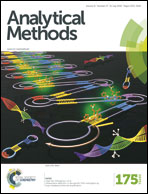Alpha-particle spectrometry for the determination of alpha emitting isotopes in nuclear, environmental and biological samples: past, present and future
Abstract
Alpha spectrometry (AS) is an important and useful radiometric analytical technique for the qualitative identification and quantitative determination of α-emitting radionuclides in environmental, biological and nuclear technology related samples. Isotope dilution alpha spectrometry (IDAS), using a suitable tracer (spike), along with a suitable method of alpha spectrum evaluation to account for the tail contribution due to energy degradation, provides accurate data on the concentration because this approach eliminates uncertainties in chemical yield in the elaborate sample preparation and purification steps. Non-isotopic tracers (N-IDAS) can also be used for the simultaneous determination of actinide isotopes. High resolution alpha spectrometry with deconvolution algorithms can now resolve close lying α-energies of radionuclide pairs e.g. (239Pu, 240Pu; 233U, 234U; 238Pu, 241Am, etc.). Nuclear decay data on the emission probabilities of different α-energies emitted by an α-emitter, and half-lives are being constantly improved by detailed critical studies at various international laboratories. Nuclear technology depends strongly on alpha spectrometry for precise and accurate data on 232U, 236Pu, 238Pu and 241Am in different fuel samples. Alpha spectrometry is poised to play an important role in the future decommissioning of aged reactors and nuclear waste disposal programs, to determine long-lived radioactive nuclides. Fast and better source preparation methods are in great demand to minimize the time to provide data on various nuclear forensic samples and in emergency contamination situations. Semiconductor passivated and implanted planar silicon (PIPS) detectors with active surface areas that range from 20 mm2 to about 2000 mm2 are used for high and low-activity samples, respectively. Exotic detectors based on cryogenic micro-calorimetry, magnetic calorimetry, and Q-value spectroscopy (using a super-conducting transition edge sensor) capable of giving an energy resolution of 1–3 keV at 5.5 MeV are being developed. Enriched isotopes of actinides and reference materials of known activity ratios are required by researchers world-wide. This review discusses recent advances that have taken place in the last decade in the important metrological radiometric technique of alpha spectrometry.


 Please wait while we load your content...
Please wait while we load your content...